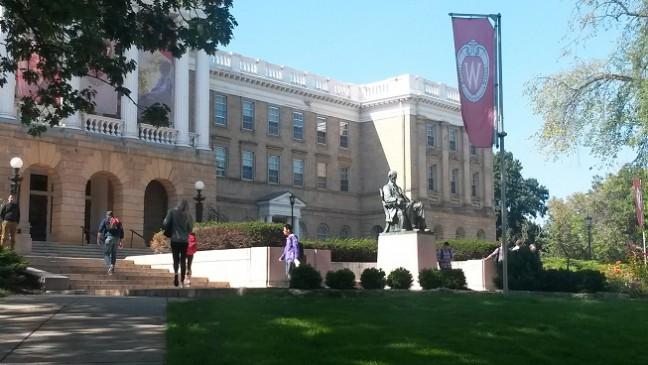As a new analysis captures persisting disparities in Wisconsin’s ACT scores for college readiness, state officials and researchers work to understand and combat issues within the educational achievement gap.
In a recent analysis conducted by the Wisconsin Policy Forum on Wisconsin ACT data from the past few years, researchers found “areas of concern” with declining and stagnant college readiness scores of high school juniors.
While the study noted Wisconsin is doing relatively better compared to other states, the WPF said Wisconsin’s decreasing working-age population and rising demand for occupations requiring higher education pose a threat to the state’s economic climate. Another cause for concern — the glaring socioeconomic and racial disparities present in ACT data.
“It’s important to note Wisconsin high schoolers still fare better on their overall ACT scores than nearly all other states that require all students to take the test,” the WPF study stated. “But within those statewide scores are gaping disparities, particularly on the basis of race, that demand urgent attention.”
While the state’s overall ACT dropped slightly from 2018 to 2019, the WPF’s analysis said the decline in levels of college readiness for math, english and science are of greater concern. These benchmark levels serve as indicators for how students will fare in college courses.
The gaps in the college readiness benchmarks are most prominent among racial lines, especially in english, where there was over a 43% gap between white students with 57% at the benchmark level compared to only 13.3% of Black students. Similar trends were found between economically disadvantaged students and other racial minorities across other subject areas.
“Few policy challenges are more critical to Wisconsin’s economic health than meeting the growing demand for college-educated workers,” the WPF stated. “At the same time, few policy solutions are as obvious as the need to boost the pipeline of high school graduates from within the state, particularly among minority and economically disadvantaged populations.”
University of Wisconsin Professor of Sociology and Educational Policy Studies Eric Grodsky said many of the inequalities in secondary and higher education can be contributed to shortcomings that take place early in the education route.
Grodsky said students are screened for literacy knowledge and skills when they come into kindergarten, and these results reveal earlier trends of disparate educational impacts, creating the gaps that grow into the high school and college years. Another significant factor is connected to Wisconsin’s disproportionate poverty rates among African Americans and other minority students, according to Grodsky.
“Wisconsin is also home to some of the biggest disparities in child poverty by race, ethnicity and median family income,” Grodsky said. “A lot going on outside the schools sets the stage for what we see inside the schools.”
Grodsky said these early educational experiences shape students’ levels of preparation for higher education, leaving African American students at a disadvantage to their non-Hispanic white peers.
Grodsky said higher education institutions play a large role in closing these gaps by reaching out to minority students. At UW, Grodsky said the admissions’ comprehensive review of applicants’ files gives students who have experienced disadvantageous situations in their education the chance to level the playing field.
“It entails looking at test scores and grades, but also looking at the totality of students, opportunities and circumstances around those test scores and grades,” Grodsky said. “I think that enables places like Madison and many others to be more nimble in trying to extend opportunities to students who may not have fared as well in primary or secondary school.”
Secretary Deputy of the Wisconsin Department of Public Instruction Mike Thompson said while Wisconsin ranks nationally, the stagnant scores and lack of improvement are cause for concern.
Thompson said the DPI is working to address the readiness gaps among minority students with key programs in early education and beyond to encourage equity at all stages of education.
“Quite frankly, our whole effort here is around equity, which means you give kids what they need, when they need it in order to achieve,” Thompson said. “We have a lot of kids that come to school … that face a lot of challenges, and schools are trying to meet those particular challenges kids face.”
UW committed to equitable admissions practices, chancellor says
Thompson said the DPI is working on raising awareness at the local level in school districts to address different needs of students in early education. For students coming into the school system behind their peers, Thompson said providing the resources they need in the vital time between kindergarten and second grade proves pivotal in making a difference.
The programs the DPI is implementing include english efficiency programs, additional training for early education teachers and after school programs to extend learning opportunities outside the classroom. Thompson said another core aspect of programming is identifying outside factors influencing students’ performance.
“Another huge area that we’re focusing on is additional resources for school districts to meet some of the other challenges that impede kids’ learning, such as trauma that they have come to school with,” Thompson said. “We know that a large number of kids, because of those particular issues, can’t really concentrate on learning and the learning environment.”
Thompson said other options include diversifying the workforce to provide role models, developing programs fostering soft skills and independence, and “early alarm” systems to identify struggling students. Additionally, Grodsky said focusing on financing higher education for lower-income students is another huge piece of the puzzle to leveling the playing field.
Grodsky is working on research with the DPI, looking at application patterns to institutions of higher education. While there are no clear cut solutions, Grodsky said educational reform holds a lot of promise to close gaps across the spectrum of disparities in Wisconsin.
“Minority student or not, education is key. And higher education is playing an important role in providing economic opportunities to young people entering the workforce,” Grodsky said. “A stepping stone to success in the graduate and professional fields is success in college.”


















